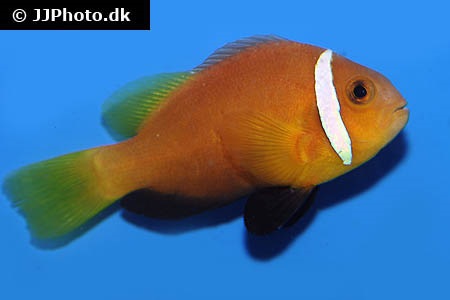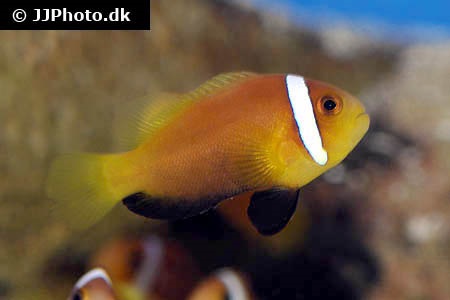Amphiprion nigripes


| Latin name | Amphiprion nigripes - Regan, 1908 |
|---|---|
| Local name | Rose Skunk Clownfish |
| Family | Pomacentridae - Amphiprion |
| Origin | East Indian Ocean |
| Max length | 11 cm (4.3") |
| Minimum volume |
100 l (26 gal) |
|---|---|
| Hardiness |
Average |
| Suitable for aquarium |
Suitable with care |
| Reef safe |
Always reef safe |
| Aggressiveness | Might be aggressive towards similar species |
| Recommended |
Microalgea (Eg. spirulina) Small crustaceans (Krill, mysis, artemia...) Zooplankton (Cyclops, pods...) |
|---|
This species is very sensitive during transportation and acclimatizing into the aquarium.
This species lives in pairs (male and female), where the female is the biggest.
One can typically have only one pair per aquarium, as it is very territorial towards its own kind.
Sometimes one can successfully keep one female and several males.
This species can change gender, male to female, where normally the female is the bigger.
This species can be bred in captivity, one can therefore consider asking your local fish store for a captive bred specimen.
Here one can find a list of the various kinds of Anemones and the fishes which typically go together with them.
Fish of the subgenus Phalerebus are mostly recognized by the white stripe running along the back- although not all species have this- and their pink/orange colour. They are delicate in comparison to other clownfish, they are for example subject to parasitic attack. They will thrive best when paired with suitable anemones.
Amphiprion akallopisos can be differentiated from A. sandaracinos in that the white stripe does not extend to the upper jaw.
Amphiprion nigripes is recognized by the black pectoral fins and the vertical white line at the head.
Amphiprion perideraion has both a white stripe along the dorsal fin and a vertical one at the head.
Amphiprion sanderacinos with this species the white stripe runs along the back all the way to the upper jaw.
Clown-/Damselfish (Pomacentridae) can be divided into three groups as described below.
Clown-/Anemonefish (Amphiprioninae) are characterised in that they spend most of their time in an anemone. They can be kept outside of one and sometimes will find another coral to hide in. This can be Hammercoral, Xenia or similar. Clownfish exhibit fascinating social behaviour, especially when carrying eggs. This is even more interesting when kept with an anemone or a substitute.
They go normally in pairs and most are easy to keep in aquaria. Clownfish can easily be kept in small tanks, as they do not swim around a lot.
It is important to have a male and female or two males to one female, as two females do not tolerate each other. When one acquires two fish of very different size or two small individuals, it is likely they will become a pair.
When setting up a reef aquarium, Clownfish are the obvious choice. They can be aggressive towards other kinds of fish, but mainly when these get too close to their hiding place. They do tend to get more aggressive when they have an anemone or when carrying eggs.
Most of Clownfish are of the Amphiprion genus, but there is a single species in the Premnas genus.
Chromis (Chrominae) encompass the genera, Acanthochromis, Altrichthys, Chromis, Azurina and Dascyllus, but when talking about Chromis it is normally understood to mean the fish of the Chromis genus specifically.
Fish in the Chromis genus are not as hardy as the Clown or Damselfish, but are very attractive with their shiny blue and green colour nuances. Overall the fish in this group are less aggressive than many others in this family and are often seen in shoals. They do become more aggressive when pairing or laying eggs.
Fish in this group live mainly on zooplankton and must be fed frequently, if possible several times a day.
Some in this group are often seen hiding in stony corals e.g. Acropora, but some species may look for shelter in anemones.
Damselfish (Pomacentrinae and Lepidozyginae) are typically hardy, very attractive, but very territorial. Some species are very coulorful when young, but become dull over time.
They live typically of a mixture of zooplankton and algae, some live more on algae and some on zooplankton. Some Damselfish even cultivate their preferred algae in a small "garden", so they have their own foodsource. This does explain their aggression towards other fish and invertebrates, which want to eat their algae.
Because of their territorial behaviour it is best to keep only one Damselfish per aquarium, unless it is a very large tank. One should consider not acquiring Damselfish, if at a later stage very peaceful or docile fish will be kept, as it is almost impossible to catch them, without removing rocks from the tank. Sometimes it is possible to entice them to hide somewhere, where they can be caught, i.e. a hollow stone. In a large aquarium where a Damselfish has its own territorium, this is a much smaller problem.
Damsels are placed in the genera; Abudefduf, Amblyglyphidodon, Amblypomacentrus, Cheiloprion, Chrysiptera, Dischistodus, Hemiglyphidodon, Hypsypops, Lepidozygus, Mecaenichthys, Microspathodon, Neoglyphidodon, Neopomacentrus, Nexilosus, Parma, Plectroglyphidodon, Pomacentrus, Pomachromis, Pristotis, Similiparma, Stegastes and Teixeirichthys.
| Aquarium trade | Yes |
|---|---|
| Distribution | Western Indian Ocean: Maldives and Sri Lanka. |
| English common names |
Maldive anemonefish Maldives anemonefish |
| Danish common names |
Maldivisk klovnfisk |
Dr. Daphne G. Fautin & Dr. Gerald R. Allen. 1992. FIELD GUIDE TO ANEMONE FISHES AND THEIR HOST SEA ANEMONES - Western Australian Museum - (English)
Henry C. Schultz. 2003. Time to Quit Clownin' Around: The Subfamily Amphiprioninae - Reefkeeping - (English)
Søanemoner og klovnfisk - Saltvandswiki.dk - (Danish)
Kenneth Wingerter. 2012. Aquarium Fish: An Overview of Clownfish of the Saddleback Complex - Advanced Aquarist - (English)
Joyce D. Wilkerson. 2013. Book Excerpt: Clownfishes: A Guide to Their Captive Care, Breeding, and Natural History - Tropical Fish Hobbyist - (English)
Scott W. Michael. 2008. Damselfishes & Anemonefishes (Reef Fishes) - TFH Publications / Microcosm Ltd. - (English)
James W. Fatherree. 2011. Aquarium Fish: Damselfishes and Chromises: the Good and the Bad - Advanced Aquarist - (English)
Bob Fenner. The Damsel and Anemonefishes, Family Pomacentridae - Wet Web Media - (English)

